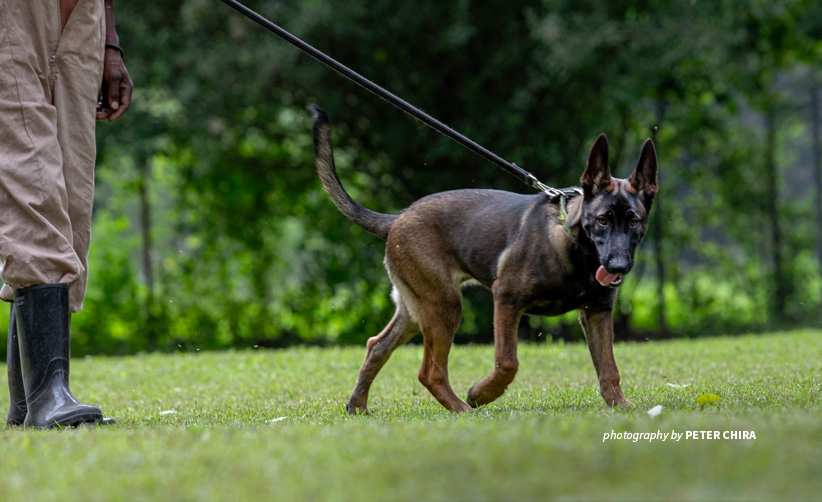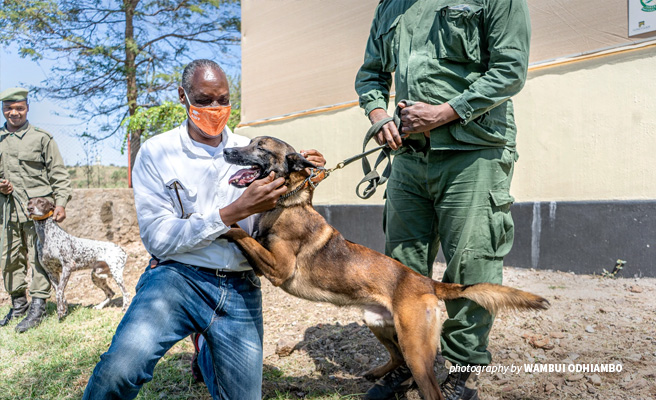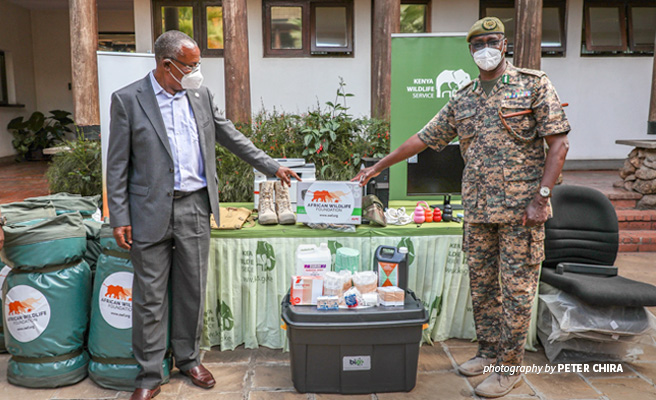AWF-trained detection and tracking dogs deter wildlife crime across Africa

382. That is the staggering number of wildlife product seizures our canine detection units have made in just East Africa alone in roughly six years. African Wildlife Foundation has trained and deployed over 70 dog handlers and 48 dogs have been trained and deployed at transit points in Kenya, Uganda, Tanzania, Botswana, and Mozambique since the inception of African Wildlife Foundation’s Canines for Conservation program in 2014. With plans to deploy these highly accurate canine teams in Cameroon and Ethiopia, AWF is determined to expand the capacity of wildlife authorities across the continent to detect and stop illegal wildlife trafficking.
Canines for Conservation trains these robust teams at a special facility in Usa River, near Arusha, Tanzania. Wildlife authority officers from partner countries are paired with their canine partners and undergo rigorous training as dog handlers before the units are deployed to airports, harbors, and border points. The program has been essential in reducing the trafficking of ivory, rhino horn, and pangolin scales among other illegal wildlife products — and even live wildlife. Substantial seizures of wildlife contraband happen on a weekly basis, narrowing trafficking routes and thereby applying pressure on poaching syndicates and local perpetrators.
Trained working canines are also very effective as tracking dogs patrolling poaching hotspots and investigating wildlife crimes on the ground. The program has worked with Tanzanian authorities to bolster their dog units patrolling protected areas in both Tarangire-Manyara and Serengeti ecosystems. AWF had previously provided technical support and equipment, and this year trained three dog handlers and four dogs to complement the Tanzania National Parks Authority’s efforts on a broader scale.
As the COVID-19 pandemic rages on, the threats to targeted species are morphing but wildlife management authorities are operating on drastically reduced budgets due to the sudden drop in revenues. In September 2020, I visited Northern Tanzania to understand the challenges facing conservation and tourism partners. I also met Canines for Conservation Director Will Powell to learn more about the program and the newly trained tracker dog unit at Fort Ikoma, conducting regular patrols in Serengeti National Park and the surrounding wildlife management areas.
![]()
AWF CEO Kaddu Sebunya and Canines for Conservation Director Will Powell discuss the impact of the tracker dog unit patrolling Serengeti National Park
Why is it important to deploy tracker dog units in protected areas?
Tracking dogs are an amazing deterrent in protecting national parks. The key aspect is to focus on few but exceptional tracking dogs who will be able to make all the difference. Currently in Tanzania, we can confidently say that the unit’s high level of efficiency has instilled fear in the perpetrators of illegal wildlife crime. Since the AWF-trained tracking unit has set up in Manyara Ranch and most recently Serengeti National Park, there have been over 100 successful tracking busts, resulting in multiple arrests of perpetrators.
Drawing from our success with the relatively small unit we are now focused on capacity building, not only in the Serengeti but across a number of key national parks in Tanzania. We aim to do this by enhancing Tanzania National Park Authority’s dog program with the tracking dogs then later on expand to the detection dog program. This will enable them to spread their resources across the board with an extreme focus on higher risk areas with species that are under specific threat such as rhinos and elephants.
In a recent incident, for instance, not far from the Ikoma dog compound, a ranger saw some tracks in area where there should not be any people. He reported his suspicions and the team opted to call in the dog team. When the dogs picked up the tracks, they were able to lead the team to a line of snares which was just at the edge of the park. The dogs were able to trace these steps to a poacher’s camp which later led to the village and all the way to the perpetrator’s house — where we found the bushmeat. Eventually, the team was able to arrest the perpetrator in the village! The great thing about these cases is not only that a successful arrest was made, but it sends the message to the whole village and the rest of the poachers: if you poach wildlife, you will certainly get caught.
Through the development of the Canines for Conservation program over the years, we have not been fixated on the number of busts or arrests that have been made. Rather, we have measured our success by asking: have the canines been able to work well as deterrents to result in no threats to wildlife completely? To this end, having canine units for both tracking and detection acts as a prophylactic towards poaching and trafficking.
How does the training regimen differ for tracker dogs and detection dogs?
Training tracker dogs takes a different approach to the training of detection dogs. For detection dogs, we teach them to look for a specific smell or item and reward them when they find it and indicate. The game is to look for a particular scent in the midst of various other smells and when they find it, they alert their handlers. Once the dog understands the routine, the canine and handler will be moved from the training area to the real environment — high-traffic transport terminals to search luggage and cargo.
When it comes to tracking dogs, at the initial stages, the training tracks are set up by the training teams but as the dogs develop it becomes harder to guide them. The dog has to be accorded time and space to figure out the track; it could be described as an evolutionary process to train the dogs fully.
The first stages of tracking are relatively easy as it involves setting out crushed vegetation and fresh tracks for the dog to follow. The dynamic, however, changes as you begin to push the dog for longer periods of tracking, sometimes even for days — this is where the complexity begins. But once the dogs get the hang of it, it is a great thing!
The determined team of handlers from the Tanzania National Parks Authority understand that the dogs need to be given time and space to figure it out by themselves — this type of support is a key factor that contributes to the success of these tracking teams.
![]()
AWF-trained Tanzania National Parks Authority handler and tracker dog during a demonstration
How are the canine handlers selected and trained for tracking units?
We select dog handlers who are already trackers in their own right — man trackers. These are individuals who are able to follow tracks using their instincts and knowledge about the environment through their human senses of sight and smell.
The majority of Tanzania National Parks Authority’s canine handlers grew up in rural areas where they would look after a herd of livestock and have to search for the missing flock through tracking their prints — this is where their journey began.
This natural instinct from an early age really helps in their training for the canine program because it is all about elevating their knowledge to offer adequate support to the dog.
When you combine a tracker in their own right with a trained tracker dog, this culminates in a powerful and focused team that understands the goal and knows how to achieve it. Gauging from our success, this model has proven very effective over the years.
Which dog breeds make for excellent tracker canines?
We work with a number of different breeds in the Canines for Conservation program. The Belgian Malinois is a good all-round dog that is great at detection, but an individual has to possess the right personality for tracking because they are naturally high-speed dogs. German Shepherds, who are a bit slower and take longer to teach, are steady and track very well. We are also experimenting with some hound breeds like the Polish Hound — we have one in Serengeti who has been tracking really well.
There has been some success in Southern Africa breeding Fox Hounds and Dobermans, so we are first going to look at integrating these breeds into the program. We have also had some success with German Shorthaired Pointers.
Ideally, we are looking for a dog who wants to track and enjoys it but also has the stamina to keep at it while withstanding the heat.
Most of our dogs come from Europe based on my 25 years of personal experience with dog clubs and individuals who train dogs as a hobby. Through our connections, we are able to obtain dogs who have a great working history by virtue of their exposure while growing up and their genetic heritage. The most successful trackers are the ones who have been exposed to different environments and know therefore know how to manage multiple situations.

AWF CEO Kaddu Sebunya with canine handler and tracker dog at Tanzania National Parks Authority facility
How has the pandemic impacted wildlife conservation in protected areas like Serengeti National Park?
COVID-19 travel restrictions have significantly hindered both domestic and international tourism and caused a reduction in revenue to protected areas. National parks like Serengeti have been able to rise above this enormous challenge by operating on minimal resources and still executing their duties of safeguarding the parks. The impact of the COVID-19 pandemic on conservation in Tanzania has not been as bad as was earlier predicted. This can be mainly attributed to the Tanzanian government’s consistent anti-poaching efforts.
The wildlife management authorities have been able to heighten security measures in poaching prone areas and this greatly kept perpetrators at bay. The use of tracker canines in these hotspots is a strong deterrent and as a result wildlife populations have recorded an increase. During this period, we have undoubtedly witnessed wildlife and biodiversity flourish in the Serengeti.
How has Canines for Conservation supported protected area authorities in light of COVID-related challenges?
Currently, there are a total of 22 national parks in Tanzania and 34 percent of the country’s government land has been dedicated to national parks. Tanzania National Parks Authority’s main mandate is to manage and protect official protected areas including national parks, conservation areas, and nature forest reserves. As you can imagine, it is a huge task, that they have managed very well so far.
At the same time, the Tanzania Wildlife Management Authority is responsible for wildlife outside national parks and gazetted areas. With TANAPA facing limited resources at the onset of the pandemic, the program stepped in and provided fuel to ensure to patrols around the parks do not stop. In conservation, we cannot afford to relax our efforts at any point. AWF has also been able to support the teams by buying food supplies for the teams when they go on patrol and for their families.

AWF Vice President, Conservation Science and Planning Dr. Philip Muruthi hands over equipment to support the Kenya Wildlife Service canine unit in Naivasha to the Director General, Brigadier John Waweru
What lessons has Canines for Conservation learned as a program?
Over the years, we have interacted with many African countries in setting up canine programs and we have learned that the agencies within the government have the capability to fulfill their mandate, they only need support to walk them through. With this collaborative attitude and approach, we have been able to work alongside these agencies to build the program from a mere concept to a center of excellence that we all take great pride in.
For instance, when the Tanzania National Parks Authority approached Canines for Conservation to rebuild the dog program in Serengeti, AWF only provided the technical guidance and TANAPA was able to construct the existing kennels. This will power, intent, and positivity from our partners has certainly propelled the success of the program.
The pivotal pillar to our achievement has been our instrumental relationships with African governments who are keen on curbing illegal wildlife trade, and therefore accord immeasurable support to Canines for Conservation. These high-level engagements have enabled the program to achieve its success through the development of resilient canine units across the continent.
What are the future plans of the Canines for Conservation program?
We envision working with government partners who are passionate about the program to ensure we have the necessary on-the-ground support to sustain our efforts against illegal wildlife trade and poaching. This is the reason why we are intentional with partner countries for the program.
Our focus is on bolstering the projects of the countries that AWF is currently based in. The next phase is selecting the best handlers from these countries and teaching them how to be trainers themselves. This will enable intercountry capacity building and thereby ensure the sustainability of the program.
The more capable resources we will be able to spread around, the more effective the program will become on a continental front. It warms my heart to see the special bond developed between the handlers and the dogs. There is a sense of family at the end of the day and I feel assured that the welfare of these dogs is well taken care of because they are with family.
As an organization, our aim is to enable countries with the technical capability to run these programs on their own, but we will always be available to offer advice where needed. Through the culture we have cultivated, AWF has been able to pass on the passion for wildlife and this helps safeguard species targeted by poachers.
> Support sniffer dogs and tracker canine teams to help stop the illegal trade of African wildlife